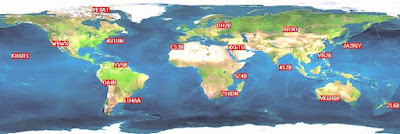Podcasting since 2005! Listen to Latest SolderSmoke
Friday, February 4, 2022
Mike WU2D -- VFO Video #3
Thursday, February 3, 2022
Exorcism Lite -- Spur Suppressed on 17 meter Transmitter -- Split TX/RX Station On The Air
2) Try putting a series LC shunt circuit tuned to 41 MHz at the output of the carrier oscillator (between the oscillator and the buffer).
3) Reduce the voltage to the oscillator/buffer. I have this on a pot, so I can adjust it down to the point where the remnant of the harmonic is no longer audible, while keeping the main carrier osc signal sufficiently strong.
It seemed to work. I could now hear the desired frequency for spotting, without the confusing tone from the spur.
Why had I been able to do this back in 2002 in the Azores using a simple trimmer cap to ground? My guess is that I was using my Drake 2-B as the receiver. The trimmer cap to ground may have reduced harmonic output. And I was probably cranking back the RF gain on the 2-B to the point where I could hear the desired signal but not the remnants of the spur. I have no RF gain control on the Barebones Barbados receiver that I am using in this project.
So, what's the lesson from all this? Well, if you are faced with a serious technical problem, and you find yourself considering complicated and difficult solutions, go to the Dominican Republic for about a month (especially if it is January or February), and then take another look at the problem when you return. If you are unable to travel this far or for this long, taking a walk or taking a weekend break from a troublesome problem will likely have a similar mind-clearing effect.
The video above shows part of a February 1, 2022 QSO with Gar WA5FWC using the split TX/RX 17 meter rig. Gar is an amazing long-time SSB homebrewer who got his start with phasing rigs back in the day.
Wednesday, February 2, 2022
The NCDXF/IARU Beacons (very useful website)
Tuesday, February 1, 2022
Mike WU2D Shows Us How to Do Temperature Compensation in Homebrew LC Analog VFOs
Wednesday, January 26, 2022
Image of James Webb Space Telescope In Position at L2
Friday, January 21, 2022
"From Crystal Sets to Sideband" -- A Great Book about Homebrew Radio by Frank Harris K0IYE (FREE!)
I first came across the above picture of K0IYE's inspirational, completely homebrew station many years ago in the pages of "World Radio" magazine. I have already linked to Frank's book many times over the years, but it is so good that I regularly feel compelled to write about it again. Frank updates the book. Just check out the introduction to his website. Frank even has a Spanish language version of his book. All for free. Thank you Frank.
The introduction to Frank's web site:
Thursday, January 20, 2022
Mike WU2D on VFOs (with additional Tribal Knowledge from Frank Harris K0IYE)
Wednesday, January 12, 2022
Looking at the Galaxy's Spiral Arms with a Dongle, a Raspberry Pi,and a Homebrew Antenna
Monday, January 10, 2022
Exorcism Not Quite Complete -- Thinking of Other Options
As often happens, I may have jumped the gun in declaring the exorcism of my 17 meter transmitter to be a success. As readers of this blog will recall, my problem was that when trying to "net" my separate 17 MHz receiver and transmitter, at around 18.116 MHz I could hear more than one tone as I tried to get to zero beat. The 8th harmonic of my 5.176 MHz carrier oscillator was mixing with the 23 MHz VXO signal and producing a spur. I could probably knock the level of this spur down below FCC limits, but -- and here is the problem -- I probably could never knock it down to the point that it would not be audible in the sensitive receiver that sits right next to the transmitter. So this is really a netting problem, not really a spur problem.
I don't want to try another filter frequency -- I have VXO crystals that really work only with a filter at 5.176 MHz.
So here is my current idea: Build a receiver board and turn this thing into a transceiver. Switch with relays the input and output of the 5.176 MHz filter, and use relays to switch to the receiver board the VXO and carrier oscillator signals.
Making this thing a transceiver would eliminate the need for netting. This should solve my problem.
What do you folks think?
73 Bill



















.jpg)









